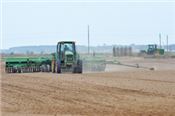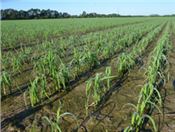|
Louisiana Rice Planting Gets Off To A Good Start

Rice is drill-seeded on the Lounsberry Farm near Lake Arthur, Louisiana, in early March.
Planting in south Louisiana is considerably ahead of the usual planting time
because of warm weather.
Photo by Bruce Schultz/LSU AgCenter
CROWLEY, LA.
Louisiana rice farmers have taken advantage of warm weather to plant their 2017 crop exceptionally early.
“We had a lot of people that started planting in mid-February,” said Steve Linscombe, director of the LSU AgCenter H. Rouse Caffey Rice Research Station.
Some farmers with large acreage had completed planting by the first week of March, Linscombe said, estimating that as much as 70 percent of the crop had been planted by March 28.
All off-station research trials in south Louisiana have been planted, and the first plots at the station were planted Feb. 17. “It just jumped out of the ground,” he said.
Warm temperatures since February and dry fields that allowed drill seeding have made planting easier for farmers to get started on this year’s crop. “The environmental conditions we are dealing with are ideal,” Linscombe said.
Most stands look good, even in fields where farmers used seed with low germination rates, he said.
Normally, seed has a germination rate of 80 percent or better, but environmental conditions last year affected the seed crop and reduced the germination percentage. In response, the Louisiana Department of Agriculture and Forestry issued an emergency ruling to lower the seed germination standards.
“It’s really been a great start to the season,” said AgCenter rice specialist Dustin Harrell.
By now, a little less than half of the crop would be planted in south Louisiana, but farmers have eclipsed that because of the warm weather. “The only reason it’s not 100 percent planted is because people are holding out to space out their planting for harvest,” Harrell said.
North Louisiana farmers are waiting for their fields to dry to start planting, he said.
Linscombe said acreage planted with hybrid seed from RiceTec is down because the company had decreased seed production last year.
A considerable amount of two new varieties – CL153, developed at the Rice Research Station, and CL172, developed by the University of Arkansas – have been planted. “I’ve been very impressed with the vigor and germination of the two new lines,” Linscombe said.
The new Provisia line of rice, also developed at the Rice Research Station, has been planted on 500-700 acres of farmers’ field for seed production. “This is with the expectation that the technology will be available on a limited basis for commercial production in 2018,” he said.
Charles Reiners, who farms near Crowley with his sons Cole and Clint and brother Pat, planted almost 300 acres of Provisia rice. That crop will generate seed for the expected release of Provisia next year.
The herbicide-resistant Provisia technology is needed on many farms, including the Reiners operation. “I think it’s going to be well received,” Reiners said.
Provisia also is being planted on 350 acres of the 2,000-acre farm of Philip, Bill, Paul and Fred Zaunbrecher, also near Crowley. “We’re eager to see what it does,” Fred Zaunbrecher said.
Yields may be low in the first versions of Provisia, just as yields were low in the initial Clearfield releases, Zaunbrecher said. “The technology is definitely going to have a fit for helping us with resistant red rice,” he said.
The Zaunbrechers also are growing the new varieties CL153 and CL172. All varieties planted on the farm have established good stands, with no problems evident from low germination, he said.
The good planting season is welcome news in light of low prices. “We need an outstanding crop because we don’t see a light at the end of the tunnel for a significant increase of prices,” Linscombe said.
South Louisiana acreage probably will be equal to last year’s total, but north Louisiana farmers who have more flexibility in what they plant may decrease their rice planting, he said. Louisiana rice farmers planted 432,000 acres last year.
Planting is just getting underway in north Louisiana. This time last year, that area was dealing with major flooding that complicated planting for many farmers, Linscombe said.
Todd Fontenot, LSU AgCenter county agent in Evangeline Parish, said about two-thirds of the crop is planted there.
“We usually have some acreage in the north part of the parish that’s planted late,” he said. A large percentage of fields were water-planted because more farmers have switched to conventional varieties to save on seed costs.
Fontenot expects the acreage to be about the same as 2016.
Andrew Granger, LSU AgCenter county agent in Vermilion Parish, said farmers are almost finished in his area. “Just about all the drill-planted rice has been planted,” he said.
Granger said he doesn’t expect much of an acreage decrease for Vermilion.
Blackbirds eating rice seed has been a big problem in Vermilion Parish in prior years, but that doesn’t seem to be the case this year. “I haven’t heard a single farmer complain about it down here,” Granger said. The bird repellent AV-1011 appears to be working.
The widespread use of the product south of I-10 could explain why the birds have become more of a problem north of the interstate where farmers haven’t used the chemical as much, Linscombe said.
Birds have been a problem, Zaunbrecher said, especially in one field that was flushed. “Those birds were pulling the sprouts up and eating the seed,” he said.
A few pounds of seed treated with the bird repellent AV-1011 were flown onto a field, and the birds left after a few hours, Zaunbrecher said.
Jeremy Hebert, county agent in Acadia Parish, said one farmer who planted 700 acres in mid-February had to replant much of the crop. “A good percentage got beat up real badly by birds,” he said.
Acreage in Acadia Parish should be about the same as last year’s 83,000 acres. “I don’t think the acreage is going to fall off much,” Hebert said.
Frances Guidry, county agent in Jefferson Davis Parish, said it’s likely that rice acreage there won’t drop much below the 81,000 acres of 2016. “I guess it will be about the same,” he said.
Vince Deshotel, LSU AgCenter county agent in St. Landry Parish, estimated 50-60 percent of the acreage there is planted. He said more farmers are returning to water-seeding conventional varieties to save money on seed costs. ∆

Rice plants grow near Crowley, Louisiana, in March.
The field will soon be fertilized and flooded.
|
|